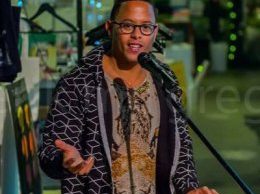Scales and Measures
I’ve awakened early the last few days because school started in earnest this week. Funny thing how the oldest habits linger (this particular one has been around since I was 6!) and become part and parcel of one’s instinctive modes of operation as though they were a kind of second skin. But that’s another story and secondary to what greeted my just-opened eyes the past Tuesday. Chris Jansing of MSNBC’s “Jansing and Co” was introducing a story about a recent opinion poll on African-American leadership, when my attention was arrested by a visual sidebar of the lead in. A still shot of Martin Luther King’s face was centrally poised with headshots (moving clockwise) of Thurgood Marshall, President Obama, W.E.B.DuBois, and Malcolm X emanating from it like rays of light. Not that the configuration looked like a halo, but given its virtually sacred iconicity, it might as well have been. It turns out that “The Grio” has recently run the result of its 2011 leadership survey so that the figures whose very familiar countenance appeared on my screen at mid-morning constitute the top five “most influential Black American leaders of all Time.” Not only did the survey appear in supplement to the federal holiday that commemorates Martin Luther King, but proactively asserts itself as a kind of bellwether to February’s Black History Month.
“The Grio” explains that it assembled “25 contemporary academics, artists, and activists to assess the most impactful African-American leaders in U.S history.” The four rubrics of leadership that guided the assembly were: 1) “Elected and Appointed Political Leaders”; 2) “Lawyers; Legal Advocates and Business Executives”; 3) “Civil Rights, Political Organizations and Religious Leadership,” and 4) “Politically Relevant Intellectuals, Writers, and Artists.” Nevermind that the only category here that specifies “political relevance” as a measurable value is the final one in reference to the “artists” and “intellectuals” in it, as though every other specimen represented in the survey were, by definition, “politically relevant” so that it needn’t have been spelled out. That any assembly of “25 contemporary academics, artists, and activists” would still feel the need, in 2011, to apologize by default for the products and producers of cultural work makes me sad, but that one would do so in the name of defining black leadership at this late date makes me mad because it suggests that nearly 50 years after America’s “quietest” revolution, I would call it, with African-American academics among its key players and beneficiaries, academic work, or the work of artists and intellectuals is perceived to have little or no value to black life and thought unless it can be deemed to be “political.”
Another way to put the question might be asked this way—assuming that all four categories of judgment in question here are commensurate and symmetrical in terms of usefulness to black folk and achievement in the canons of black leadership, then wouldn’t all of them express political relevance, and if that is so, then what would the political relevance of category #4 consist in that would have no equal or analogy in categories 1,2,and 3? And furthermore, why did I see no woman’s head among the headshots emanating from King’s, even though notable black women figures occupy positions 7-10 among the top ten winners of the survey? After all, half the black people, too, are female. And why does the President, two years into a first term of office, appear in this survey?
We would have to guess that his inclusion here among the already-finished biographies marks the fact that whatever his Presidency might actually achieve, (as the Obama era remains a work in progress) he will always be the “first” African-American to serve as President of the United States, and from that point of view uniquely, he has earned an eminent place in the historical record; but is the accomplishment of a black presidency for black people— the latter is what the survey purports to be about— something other than a symbolic victory, as powerful as that may be? And how could we know the answer to that question only two years later, with black unemployment in the United States nearly twice the national average at the moment? In short, this little thing and that little thing and the other little thing about “The Grio” report made me hit the floor rather faster and harder than I might have, and I suppose that’s a good thing, but still. . .
The particulars of this survey do not bother me so much as its apparent logic and the fact that we seem to need such a thing quite often. Why is that? Nearly a century ago, Carter G. Woodson elaborated a historiographical project that had commenced at the close of the nineteenth century with W.E.B.DuBois, whose systematic studies and analyses of black life and thought, as well as aspects of African and African Diasporic cultures, provided the paradigmatic instance of a proto-typical global “Black Studies.” With Alexander Crummell, DuBois’ co-founding of the American Negro Academy in 1898 and his early researches—The Suppression of the African Slave Trade and The Philadelphia Negro, among them—all played a crucial role in establishing black life as a subject of systematic critical inquiry at the instigation, at the hands of black scholars, we must emphasize.
In other words, African-descended communities had long been the object of investigation by distant others, not always sympathetic to their interests or sensitive to their aspirations, but one of the inevitable results of post-emancipation social development in the United States was the radical breach of a pathway to intellectual cultivation and maturity, once foreclosed by the regimes of bondage, but now abruptly thrown open to the free man and the free woman. DuBois and Woodson were among the first in the breach, making it possible for black historical subjects, generations after them, to choose the life of the mind without fear, without apology. Ten years after Woodson founded the Association for the Study of Negro Life and History (ASNLH) in 1915 and launched the Journal of Negro History the following year, he created “Negro History Week” in 1926. Over the decades, the latter would eventually undergo transformation into “Black History Month,” as we know the month of February today.
My idea of Woodson’s creative gesture regarding “Negro History Week” is that it aimed to popularize the discourses of learning that had to do with explanations of very complex historical currents and sequences; in doing so, it challenged the notion that one inherently knew his history, or that he came to it “naturally.” Instead, one became a student of it, even though he were Negro or black. But as “Negro History” taught self- and communal pride (even fostered the growth of black nationalism/exceptionalism) as a by-product of the deeper analysis that it intended, it became a substitute for hagiographical motives that dulled its analytical edge. Perhaps we could say that all commemorative gestures, conservative in character, recover only the most superficial aspects of an imagined or actual event and as a result empty the transformative moment of the savor of its meaning. By a similar logic, our search for the “most impactful black leaders” in all the forms and manifestations that such pursuit might take repeats the rituals of hagiography, stylizes any radical potential by staging its content as an act of closure, but may not do much to illumine our condition today.
To show appreciation for where we’ve been and how we arrived there is one way to express gratitude for the benefits of humanity passed on to us from others, but there is a next step, which we tend to refuse, and that is to say, regarding the human landscape as an open possibility rather than the play of hierarchy and privilege. Trying to learn about the latter is the measure of freedom and perhaps freedom “for all time.”




6 Comments